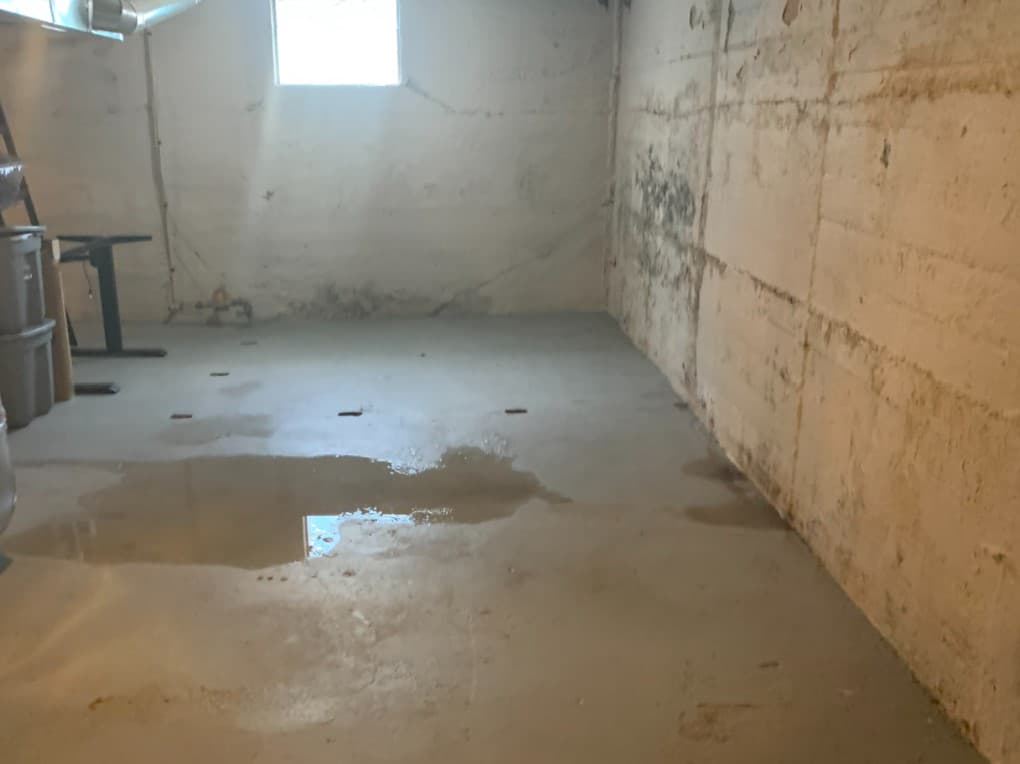
[et_pb_section fb_built="1" admin_label="section" _builder_version="4.16" global_colors_info="{}"][et_pb_row admin_label="row" _builder_version="4.16" background_size="initial" background_position="top_left" background_repeat="repeat" custom_margin="|auto||14px||" global_colors_info="{}"][et_pb_column type="4_4" _builder_version="4.16" custom_padding="|||" global_colors_info="{}" custom_padding__hover="|||"][et_pb_text admin_label="Text" _builder_version="4.27.4" background_size="initial" background_position="top_left" background_repeat="repeat" hover_enabled="0" global_colors_info="{}" sticky_enabled="0"]No one likes discovering that a basement leak repair is necessary when water starts seeping into your home. It’s a universally unpleasant experience. In fact, there’s only one thing that makes it worse: you find the water intrusion by stepping in it while wearing socks. There’s something deeply unsettling about soggy wet fabric stuck to your feet—it prompts the bravest of us to curl our toes and rip off our socks with disgust.
If you’re dealing with this in a Michigan basement, you might wonder: why does it seem so prone to leaks? Once you’ve removed your soggy footwear and taken a good look at your wet basement, you think to yourself, “now what?!”
Table of Contents
The first thing you need to do is identify the source of the water. If it’s coming from a pipe, a shut-off valve, or an appliance connection, you’re going to need a plumber. However, if the water is seeping through the basement walls or floor, you’ll want to hire someone who specializes in foundation repair and basement waterproofing.
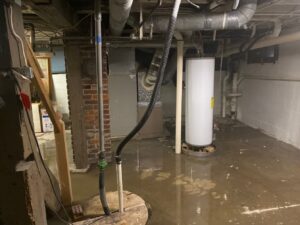 Photo taken by an Acculevel customer. This situation prompted them to call us for a permanent fix to their leaky basement!
Photo taken by an Acculevel customer. This situation prompted them to call us for a permanent fix to their leaky basement!
Acculevel is a family-owned and operated company that has been repairing foundations and waterproofing basements since we opened our doors in 1996. During our decades of service, we’ve helped more than 35,000 homeowners restore their homes to full health and stability. We focus on providing whole-home solutions, addressing both the symptoms and the root causes of basement water damage.
In this blog, we’re going to discuss the types of basement leaks, what causes them, and the best methods for basement leak repair near you.
This may seem obvious, but stick with us for a moment. If you’re noticing water intrusion during major rain events, your home may require foundation leak repair to prevent long-term water damage. In many cases, the issue isn’t inside your basement—it starts outside, where excess water accumulates around your foundation and seeps into small cracks and joints.
There are several effective ways to reduce water buildup near your foundation, helping to prevent leaks and maintain the structural integrity of your home.

This photo was taken by an Acculevel crew member while installing a downspout extension at a customer’s home.
If you have a wet basement even when it’s not raining, or if the DIY solutions mentioned above haven’t solved the issue, you likely need someone who specializes in foundation repair in Missouri to prevent ongoing water damage.
Persistent moisture problems often indicate a deeper issue, such as hydrostatic pressure forcing water intrusion through the foundation, which can compromise your home's stability over time.
In such cases, professional basement waterproofing or crawl space encapsulation may be necessary to create a watertight barrier and protect your home’s structural integrity for years to come.
You may have heard the term hydrostatic pressure before before because it’s often discussed in the same breath as wet basements. This pressure develops when there is more water in the ground than the soil can absorb. If you put a sponge in a bucket of water, the sponge will soak up some of it. But what happens to the excess? It doesn’t magically vanish—it remains, freely sloshing around.
This is true of the excess groundwater near your home—when water encounters an obstacle like your foundation walls, it begins to pool and create pressure. Over time, this pressure forces water through cracks, leading to foundation leaks and basement water intrusion.
If you have expansive soil (clay based) or live in an area with a high water table, you are more likely to experience foundation leaks due to hydrostatic pressure. The soil retains moisture, and during heavy rain or seasonal flooding, the added water creates even greater pressure on your foundation, eventually leading to water seepage and structural weakening.

Water leaking into basement: Photo taken by an Acculevel project advisor during a free in-home assessment.
Water intrusion caused by hydrostatic pressure can happen anywhere in the basement—through the walls, floors, or the cove joint where they meet (as shown in the image above). The most effective way to address these foundation leaks is through professional basement waterproofing.
When dealing with persistent water intrusion, we strongly recommend an interior drainage system over exterior waterproofing due to the significant differences in repair time, cost, and property disruption. If you're searching for basement leak repair near you, it's important to choose a solution that not only stops moisture but also protects your foundation from long-term damage.
(We compare interior versus exterior drainage systems in this blog.)
Please understand that waterproofing is not recommended solely to address water intrusion.
Basement water leak repair isn’t just about stopping moisture intrusion—it’s also about relieving hydrostatic pressure that can weaken your foundation over time. Left unaddressed, saturated soil surrounding your home can cause major structural damage and contribute to a leaking basement.
Interior basement waterproofing requires two components: a drainage system and a sump pump. The original poured concrete floor is removed around the perimeter of your basement, and the drain tile is placed on top of (or next to) your foundation’s footing. Once the drainage is installed, new concrete is poured over the top of it to restore your basement floor.
The drain tile collects water as it comes through the foundation and directs it to the “pit” where the sump pump is installed. This sump pump then empties the water out of your basement through a discharge line. This line releases the water a safe distance away from the foundation.
 This photo was taken by an Acculevel team member after installing water drainage under the basement floor and directing it to the sump pump pit.
This photo was taken by an Acculevel team member after installing water drainage under the basement floor and directing it to the sump pump pit.
Depending on where and how the water seepage occurs, additional repairs may be needed to ensure long-term protection:
If water buildup occurs under your house, you may need to add drainage lines across the basement floors to prevent puddles or cracks from forming. This drainage can usually be routed to the same sump pump pit to drain away.
However, If water leaks through multiple points in a basement wall, you may need encapsulation. We often recommend this additional step if your foundation is built out of brick or stone because these materials (along with mortar joints) are more porous than concrete.
Encapsulation is especially necessary if you plan to finish your basement and convert it into living space, as it provides long-term moisture control and prevents water damage to walls and flooring.
When you encapsulate a basement, a specialized waterproof liner is applied to the walls from floor to ceiling. This barrier must be made from inorganic material to prevent mold growth and maintain a watertight seal that protects your home from moisture intrusion.
The liner needs to be securely attached to the top of the basement walls, creating a moisture-resistant shield. A slight gap is left between the liner and the foundation, allowing water to penetrate through the foundation walls while ensuring it doesn’t escape into your home. Instead, the liner traps excess moisture and channels it into the drainage system, keeping your basement dry and structurally sound.
This liner also protects finishing materials such as insulation, drywall, and wooden joists, making encapsulation essential for homeowners who want to fully waterproof their basement space.
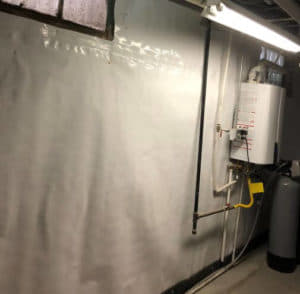 Photo taken by an Acculevel team member. Water drainage and encapsulation installtion.
Photo taken by an Acculevel team member. Water drainage and encapsulation installtion.
You will also need to install a dehumidifier to regulate moisture levels inside your basement. Encapsulation stops water seepage, but it does not prevent condensation, which occurs due to temperature differences between the interior and exterior of your home.
It may seem like condensation is a minor problem, but even this small amount of excess moisture can feed biological growth, which can have a significant negative impact on your home’s air quality.
A dehumidifier is an excellent way to prevent harmful microbes and particles from developing and creating health risks for you and your family.
As we referenced earlier, hydrostatic pressure is one of the most common causes of foundation cracks, leading to water intrusion over time. While some cracks may initially appear dry, they widen over time, allowing water, soil, and debris to seep through. Addressing cracked basement walls early is key to effective basement leak repair and preventing further structural damage.
If the crack is thin and only allows a small amount of water to intrude, epoxy fill is the ideal solution. We recommend this repair method because it has consistently provided the best results for us and our customers.
Unlike other sealants or injection methods, the epoxy we use has a flexible quality, allowing it to adjust with seasonal foundation movement. As your foundation expands and contracts, the epoxy fill shifts accordingly, preventing further cracking.
At Acculevel, crack repairs include a 5-year warranty, and epoxy fill has been the most effective and long-lasting repair option. While it’s a strong color (see below), the epoxy fill can also be painted over if you would like to make the repairs to your basement walls less noticeable.
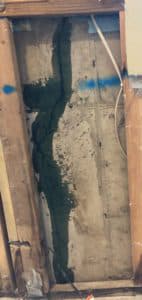
Photo was taken by an Acculevel team member after repairs. Drywall was removed in the finished basement to gain access to the basement leak.
You might expect that a larger crack would automatically allow more water intrusion, but this isn’t always the case. Some large cracks develop without leaking initially, depending on where and when they form. However, even when dry, large foundation cracks can pose a serious risk to your home’s structural integrity.
We’re not talking about thin, hairline cracks—these larger cracks usually form in specific patterns that indicate foundation instability. If your basement wall has developed a long horizontal crack, even if it isn’t leaking yet, it should be assessed immediately. Similarly, stair-step or zig-zag cracks are also signs of foundation movement that require prompt attention.
Generally speaking, poured concrete foundation walls only develop long horizontal cracks. A concrete or cinder block wall can develop either horizontal or stair-step ones because the cracks can follow along the mortar joints.

This photo was taken by an Acculevel project advisor during a free estimate. The foundation wall has both types of cracks: horizontal and zig-zag.
Regardless of the foundation material, larger cracks should never be ignored. Foundation damage is a sign that your basement wall may be bowing or leaning inward, which requires structural reinforcement rather than just crack sealing.
If one or more of your basement walls are bowing or leaning inward less than 2 inches, carbon fiber straps are the best option for you and your home. These repairs can also be painted over to minimize their appearance once thoroughly cured and dry. When installed by a qualified foundation contractor, carbon fiber straps should be a permanent solution.
we warranty this repair type for the life of your home’s structure. If bowing walls go untreated, they can contribute to more severe foundation issues, leading to the need for foundation leak repair to prevent water intrusion and structural instability.
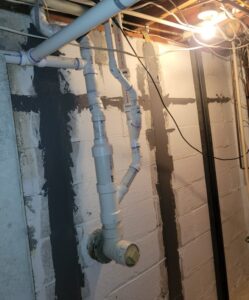
This photo was taken by an Acculevel team member after both epoxy repairs and carbon fiber straps were completed.
Please use our homeowner’s guide to basement waterproofing. This free resource includes common signs of water damage, the value of downspout extensions, the difference between drainage tile and a French drain system, the costs for waterproofing and encapsulation, and many other frequently asked questions.
Do you need more information about the types of cracks you may see in your foundation? This article explains the three major types of foundation cracks, how urgently they need to be repaired, and more resources for each one.
For homeowners experiencing consistent water intrusion, investing in basement water leak repair near you may be necessary to fully protect your home and prevent costly damage.
It’s important that you work with a reputable foundation or basement waterproofing contractor who is properly insured and accredited by the Better Business Bureau. Not sure how to determine if a business is the right fit for you? Use our checklist of questions to ask a contractor, which provides both the right questions to ask and when you should be cautious of a certain type of response.
If you live in Indiana or the surrounding areas, call Acculevel. We have an A+ rating with the BBB, treat every home as if it were our own, and focus on providing whole-home solutions for our customers. We believe that a proper solution addresses both the symptoms you’ve noticed as well as the condition(s) that are creating symptoms.
If you're dealing with persistent moisture issues or foundation cracks, professional basement work - including basement leak repair in Cedar Rapids, as well as foundation repair in Arlington Heights - can help prevent long-term damage and ensure a dry, secure home.
If it’s after business hours, or you would prefer written communication, complete our online form instead! We’ll schedule an appointment for you with one of our knowledgeable and experienced project advisors. They will meet with you to discuss your concerns, evaluate your home, and then carefully review the best options and repair methods to meet your goals and needs.
If your home is experiencing persistent moisture issues, leaking foundation repair may be the best way to ensure long-term protection and prevent further structural damage.
Illinois Basement Waterproofing
Indiana Basement Waterproofing
Kentucky Basement Waterproofing
Michigan Basement Waterproofing
Missouri Basement Waterproofing
Wisconsin Basement Waterproofing
[DISPLAY_ULTIMATE_SOCIAL_ICONS]
[/et_pb_text][/et_pb_column][/et_pb_row][/et_pb_section]